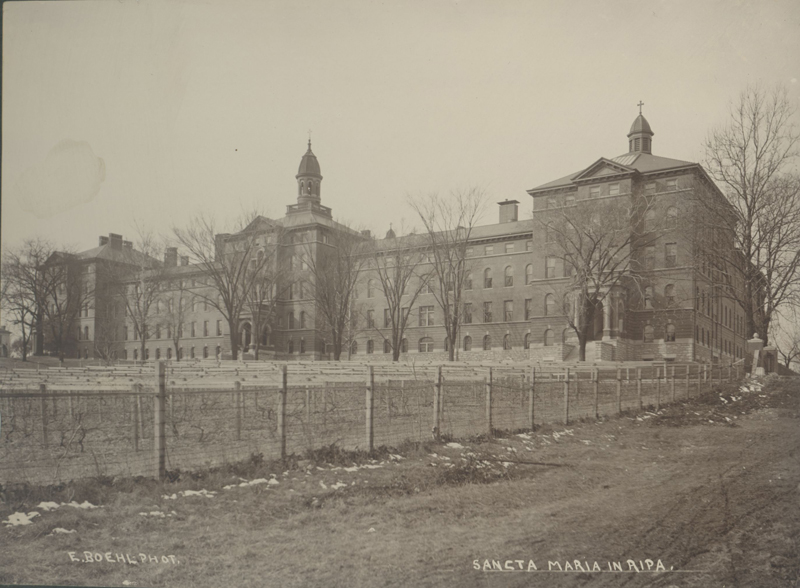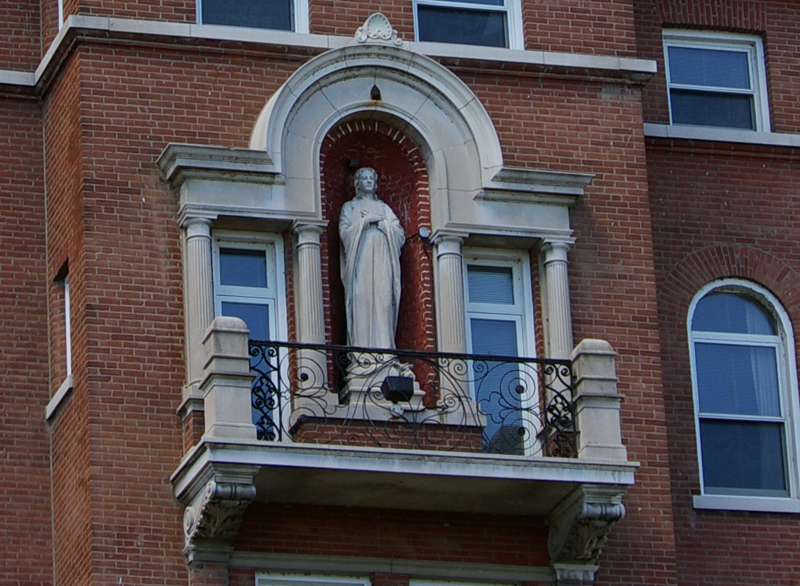
Sancta Maria in Ripa
Construction of an important structure
In 1894, the sisters purchased a 21-acre site near the Mississippi River, which they named Sancta Maria in Ripa (St. Mary on the Bank). The property included a ten-room mansion, called the “White House.” The house served as the convent for the sisters while the motherhouse was under construction.
Additional historical information can be found in the Heritage Room, which offers details and artifacts from the sisters’ history in St. Louis, including items showing how sisters’ lives have changed over time.
Stories of the Early Days at Ripa
The following are excerpts from an unpublished manuscript called “Stories of the Early Days at Ripa,” written by Sister Anisia Breiner. Sister Anisia was one of the seven pioneers who came to live in the “White House,” on March 15, 1895. Her account provides rich detail about the early life in Ripa and the construction of the motherhouse.
“When the sisters came to stay permanently in their ‘White House,’ they found this, indeed, empty, dusty, and cold. First they made an investigation tour from cellar to garret to see how many rooms there were, and where they might put the beds. They then set to work to unpack and to arrange things so as to make it look homelike…When night came, all were very tired, and after having said night prayer in the little room destined to be the chapel, they retired. It was only the next morning that they found they had neglected to unpack their wash basins. As is usually the case in pioneer days, there were many things wanting, but the sisters bore all cheerfully…”
“A few weeks after the blessing of the old house, the work on the foundation for the new building was begun. Then the hill side presented a picturesque scene. It looked like a veritable gypsy town for many of the laborers brought their entire families along and erected for themselves temporary buildings as shelter. Some built frame houses or cottages, others simply struck up tents. On the First Friday of June the laying of the foundation was begun. The stones for this were taken from the quarry on our own grounds…”
“[Laying of the cornerstone, October 15, 1895]…The sisters had made a little booth where they served sandwiches and coffee. At three o’clock a bell was rung for everybody to march in the procession to the place where the cornerstone laying was to take place. Sister Anisia was still cooking coffee when the bell rang, but at the first sound of the bell she covered her coffee and hurried to the place where the cornerstone was to be laid. However, when she had gone half way, she suddenly turned around, and to her big surprise, she saw the entire procession of dignitaries and people behind her. Greatly embarrassed she hid behind some bricks until the procession had passed…”
“The framework of the building had been completed up to the third story when on the twenty-seventh of May the terrible cyclone struck St. Louis. The sisters had observed the storm clouds pass over south St. Louis, and the storm blew so fiercely that strong trees were bent to the ground, but not a plank or board was blown from the building or even moved about, yet on the top floor the boards were lying loosely. It was only when remnants of houses, lumber and trunks of trees floated down the river that the sisters began to realize that the cyclone had caused disaster in the neighborhood. It was sad and painful for the sisters to see people clinging to planks and branches of trees, and calling loudly for help, and not be able to save the unfortunate, for there was no possibility of reaching them, since the river had risen so much that the entire meadow bordering Ripa’s grounds and the river, had been inundated…”
 “It was very much in place that a statue of Our Lady should ornament Ripa. On the main entrance we see a beautiful statue of the Virgin Queen, and it was such an immense piece of work that put her in her niche that the workmen spent an entire day to put her in her destined place. In the evening when the workmen had left for their homes, Mother Bonaventure with her little community went in procession to greet the Blessed Mother. The Sisters prayed, and then sang, ‘Star of the Sea.’”
“It was very much in place that a statue of Our Lady should ornament Ripa. On the main entrance we see a beautiful statue of the Virgin Queen, and it was such an immense piece of work that put her in her niche that the workmen spent an entire day to put her in her destined place. In the evening when the workmen had left for their homes, Mother Bonaventure with her little community went in procession to greet the Blessed Mother. The Sisters prayed, and then sang, ‘Star of the Sea.’”
